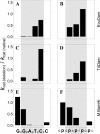Symmetry elements in DNA structure important for recognition/methylation by DNA [amino]-methyltransferases
- PMID: 15280508
- PMCID: PMC506800
- DOI: 10.1093/nar/gkh712
Symmetry elements in DNA structure important for recognition/methylation by DNA [amino]-methyltransferases
Abstract
The phage T4Dam and EcoDam DNA-[adenine-N6] methyltransferases (MTases) methylate GATC palindromic sequences, while the BamHI DNA-[cytosine-N4] MTase methylates the GGATCC palindrome (which contains GATC) at the internal cytosine residue. We compared the ability of these enzymes to interact productively with defective duplexes in which individual elements were deleted on one chain. A sharp decrease in kcat was observed for all three enzymes if a particular element of structural symmetry was disrupted. For the BamHI MTase, integrity of the ATCC was critical, while an intact GAT sequence was necessary for the activity of T4Dam, and an intact GA was necessary for EcoDam. Theoretical alignment of the region of best contacts between the protein and DNA showed that in the case of a palindromic interaction site, a zone covering the 5'-symmetric residues is located in the major groove versus a zone of contact covering the 3'-symmetric residues in the minor groove. Our data fit a simple rule of thumb that the most important contacts are aligned around the methylation target base: if the target base is in the 5' half of the palindrome, the interaction between the enzyme and the DNA occurs mainly in the major groove; if it is in the 3' half, the interaction occurs mainly in the minor groove.
Figures


Similar articles
-
The cytosine N4-methyltransferase M.PvuII also modifies adenine residues.Biol Chem. 2001 Apr;382(4):707-10. doi: 10.1515/BC.2001.084. Biol Chem. 2001. PMID: 11405235
-
Transition from EcoDam to T4Dam DNA recognition mechanism without loss of activity and specificity.Chembiochem. 2009 Oct 12;10(15):2488-93. doi: 10.1002/cbic.200900441. Chembiochem. 2009. PMID: 19725089
-
On the substrate specificity of DNA methyltransferases. adenine-N6 DNA methyltransferases also modify cytosine residues at position N4.J Biol Chem. 1999 Jul 9;274(28):19538-44. doi: 10.1074/jbc.274.28.19538. J Biol Chem. 1999. PMID: 10391886
-
Structure and function of DNA methyltransferases.Annu Rev Biophys Biomol Struct. 1995;24:293-318. doi: 10.1146/annurev.bb.24.060195.001453. Annu Rev Biophys Biomol Struct. 1995. PMID: 7663118 Review.
-
The use of prokaryotic DNA methyltransferases as experimental and analytical tools in modern biology.Anal Biochem. 2005 Mar 1;338(1):1-11. doi: 10.1016/j.ab.2004.02.048. Anal Biochem. 2005. PMID: 15707929 Review.
Cited by
-
Genome-wide high-resolution mapping of DNA methylation identifies epigenetic variation across embryo and endosperm in Maize (Zea may).BMC Genomics. 2015 Jan 23;16(1):21. doi: 10.1186/s12864-014-1204-7. BMC Genomics. 2015. PMID: 25612809 Free PMC article.
-
Extension of bacterial rDNA sequencing for simultaneous methylation detection and its application in microflora analysis.Sci Rep. 2023 Apr 7;13(1):5731. doi: 10.1038/s41598-023-28706-w. Sci Rep. 2023. PMID: 37029177 Free PMC article.
-
Isospecific adenine DNA methyltransferases show distinct preferences towards DNA substrates.Sci Rep. 2018 May 29;8(1):8243. doi: 10.1038/s41598-018-26434-0. Sci Rep. 2018. PMID: 29844340 Free PMC article.
-
MeinteR: A framework to prioritize DNA methylation aberrations based on conformational and cis-regulatory element enrichment.Sci Rep. 2019 Dec 16;9(1):19148. doi: 10.1038/s41598-019-55453-8. Sci Rep. 2019. PMID: 31844073 Free PMC article.
-
Species-specific typing of DNA based on palindrome frequency patterns.DNA Res. 2011 Apr;18(2):117-24. doi: 10.1093/dnares/dsr004. Epub 2011 Mar 23. DNA Res. 2011. PMID: 21429991 Free PMC article.
References
-
- Barras F. and Marinus,M.G. (1989) The great GATC: DNA methylation in E. coli. Trends Genet., 5, 139–143. - PubMed
-
- Cheng X. (1995) Structure and function of DNA methyltransferases. Annu. Rev. Biophys. Biomol. Struct., 24, 293–318. - PubMed
-
- Wu J.C. and Santi,D.V. (1987) Kinetic and catalytic mechanism of HhaI methyltransferase. J. Biol. Chem., 262, 4778–4786. - PubMed
-
- Malone Th., Blumenthal,R.M. and Cheng,X. (1995) Structure-guided analysis reveals nine sequence motifs conserved among DNA amino-methyltransferases, and suggests a catalytic mechanism for these enzymes. J. Mol. Biol., 253, 618–632. - PubMed
-
- Jeltsch A. (2002) Beyond Watson and Crick: DNA methylation and molecular enzymology of DNA methyltransferases. Chembiochem, 3, 274–293. - PubMed
Publication types
MeSH terms
Substances
Grants and funding
LinkOut - more resources
Full Text Sources
Molecular Biology Databases

